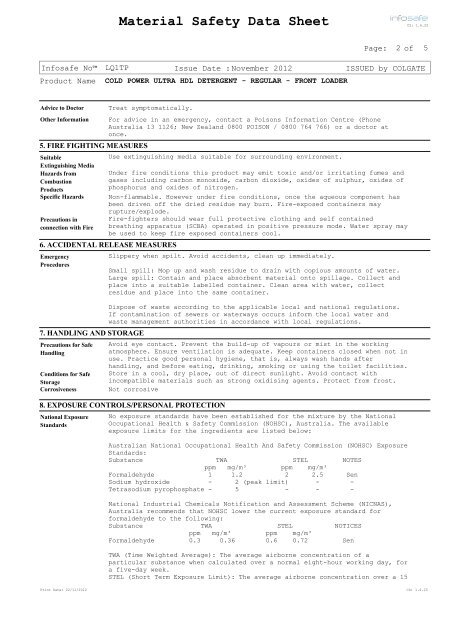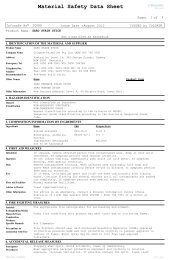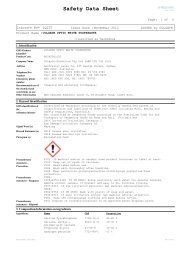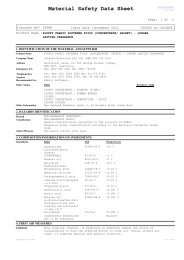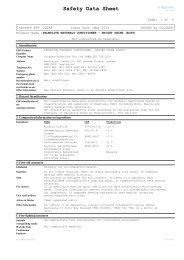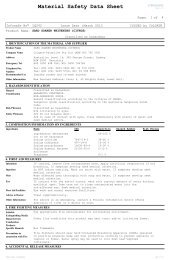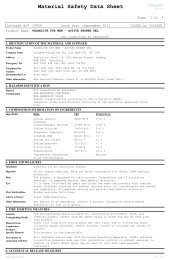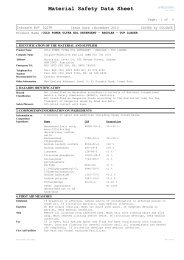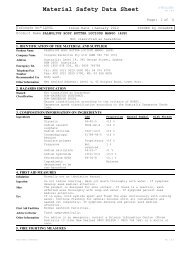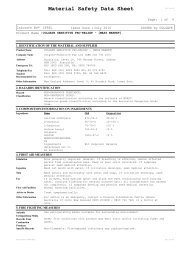Cold Power Liquid - Colgate
Cold Power Liquid - Colgate
Cold Power Liquid - Colgate
- No tags were found...
You also want an ePaper? Increase the reach of your titles
YUMPU automatically turns print PDFs into web optimized ePapers that Google loves.
Material Safety Data SheetCS: 1.6.25Page: 2of5Infosafe No LQ1TP Issue Date : November 2012 ISSUED by COLGATEProduct Name :COLD POWER ULTRA HDL DETERGENT - REGULAR - FRONT LOADERAdvice to DoctorOther Information5. FIRE FIGHTING MEASURESSuitableExtinguishing MediaHazards fromCombustionProductsSpecific HazardsPrecautions inconnection with FireTreat symptomatically.For advice in an emergency, contact a Poisons Information Centre (PhoneAustralia 13 1126; New Zealand 0800 POISON / 0800 764 766) or a doctor atonce.Use extinguishing media suitable for surrounding environment.Under fire conditions this product may emit toxic and/or irritating fumes andgases including carbon monoxide, carbon dioxide, oxides of sulphur, oxides ofphosphorus and oxides of nitrogen.Non-flammable. However under fire conditions, once the aqueous component hasbeen driven off the dried residue may burn. Fire-exposed containers mayrupture/explode.Fire-fighters should wear full protective clothing and self containedbreathing apparatus (SCBA) operated in positive pressure mode. Water spray maybe used to keep fire exposed containers cool.6. ACCIDENTAL RELEASE MEASURESEmergencyProcedures7. HANDLING AND STORAGEPrecautions for SafeHandlingConditions for SafeStorageCorrosivenessSlippery when spilt. Avoid accidents, clean up immediately.Small spill: Mop up and wash residue to drain with copious amounts of water.Large spill: Contain and place absorbent material onto spillage. Collect andplace into a suitable labelled container. Clean area with water, collectresidue and place into the same container.Dispose of waste according to the applicable local and national regulations.If contamination of sewers or waterways occurs inform the local water andwaste management authorities in accordance with local regulations.Avoid eye contact. Prevent the build-up of vapours or mist in the workingatmosphere. Ensure ventilation is adequate. Keep containers closed when not inuse. Practice good personal hygiene, that is, always wash hands afterhandling, and before eating, drinking, smoking or using the toilet facilities.Store in a cool, dry place, out of direct sunlight. Avoid contact withincompatible materials such as strong oxidising agents. Protect from frost.Not corrosive8. EXPOSURE CONTROLS/PERSONAL PROTECTIONNational ExposureStandardsNo exposure standards have been established for the mixture by the NationalOccupational Health & Safety Commission (NOHSC), Australia. The availableexposure limits for the ingredients are listed below:Australian National Occupational Health And Safety Commission (NOHSC) ExposureStandards:Substance TWA STEL NOTESppm mg/m³ ppm mg/m³Formaldehyde 1 1.2 2 2.5 SenSodium hydroxide - 2 (peak limit) - -Tetrasodium pyrophosphate - 5 - - -National Industrial Chemicals Notification and Assessment Scheme (NICNAS),Australia recommends that NOHSC lower the current exposure standard forformaldehyde to the following:Substance TWA STEL NOTICESppm mg/m³ ppm mg/m³Formaldehyde 0.3 0.36 0.6 0.72 SenTWA (Time Weighted Average): The average airborne concentration of aparticular substance when calculated over a normal eight-hour working day, fora five-day week.STEL (Short Term Exposure Limit): The average airborne concentration over a 15Print Date: 22/11/2012 CS: 1.6.25


